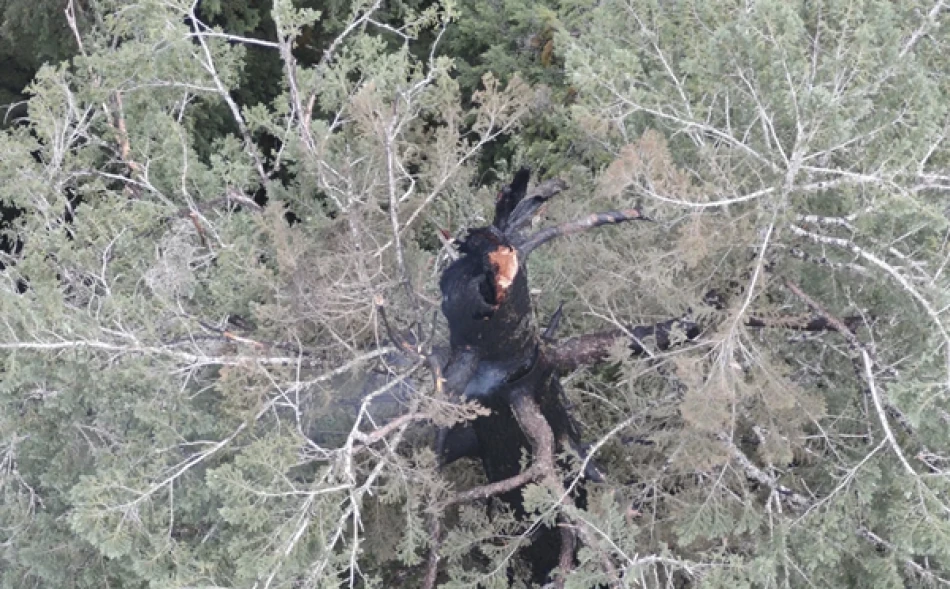
Massive Blaze Consumes One of the World's Tallest Trees, Sparking Global Concern
Oregon's 450-Year-Old Giant Tree Burns from Within as Firefighters Face Unprecedented Challenge
A fire burning inside one of the world's tallest trees—a 325-foot coastal fir estimated at over 450 years old—has presented Oregon authorities with an extraordinary firefighting challenge that highlights the growing vulnerability of ancient forests to climate-driven blazes. The Doerner Fir has been smoldering since Saturday, with heat detected deep within its trunk cavity nearly 280 feet above ground.
The Engineering Challenge of Fighting Fire in the Sky
Infrared drone footage revealed Tuesday that while no active flames or smoke were visible at the tree's crown, significant heat remained trapped within a hollow section of the massive trunk. This presents firefighters with a logistical puzzle rarely encountered in wildfire management.
Federal Bureau of Land Management spokesperson Megan Harper outlined the complex options under consideration: constructing scaffolding systems, climbing adjacent trees to gain better access points, or allowing the ancient giant to burn slowly under careful monitoring. A helicopter remains on standby for precision water drops if the situation escalates.
When Traditional Firefighting Meets Ancient Giants
The Doerner Fir's predicament underscores how climate change is creating novel challenges for forest management. Unlike typical ground fires that can be attacked with conventional methods, internal tree fires in specimens of this magnitude require specialized approaches that balance preservation with safety.
The tree's location in Oregon's Coast Range adds another layer of complexity. These old-growth coastal forests represent irreplaceable ecosystems that took centuries to develop, making each ancient specimen particularly valuable from both ecological and carbon storage perspectives.
Lightning Strike Investigation Points to Broader Climate Patterns
While the fire's cause remains under investigation, authorities are examining lightning data for recent strikes in Coos County. The focus on lightning reflects a growing concern among forest managers: as climate patterns shift, lightning-sparked fires are becoming more frequent and intense across the Pacific Northwest.
The fact that only this single tree is burning, rather than a broader forest fire, suggests either a precise lightning strike or another localized ignition source. This isolation, while preventing widespread damage, also means the Doerner Fir cannot benefit from standard wildfire suppression tactics designed for larger blazes.
Economic and Ecological Stakes of Ancient Tree Preservation
The Doerner Fir represents more than just a natural curiosity. Ancient trees like this serve as critical carbon sinks, storing decades or centuries worth of atmospheric carbon in their massive trunks. The loss of such specimens contributes to carbon release while eliminating future sequestration capacity.
From a tourism and research perspective, trees of this age and size draw visitors and scientists from around the world. Oregon's old-growth forests contribute significantly to the state's outdoor recreation economy, which generates billions in annual revenue.
Precedent for Protecting Irreplaceable Natural Assets
The intensive effort to save a single tree reflects evolving approaches to conservation. Similar high-stakes preservation efforts have been mounted for ancient specimens worldwide, from California's General Sherman sequoia to Australia's Wollemi pines, demonstrating that individual trees can warrant extraordinary protective measures when their ecological or historical value justifies the expense.
The outcome of Oregon's firefighting efforts may establish new protocols for protecting ancient trees from internal fires, potentially informing future responses as climate change continues to threaten irreplaceable forest giants across the globe.
Most Viewed News

 Layla Al Mansoori
Layla Al Mansoori






